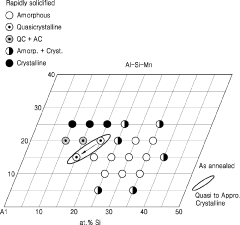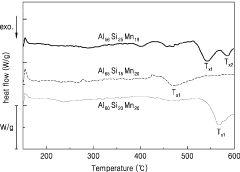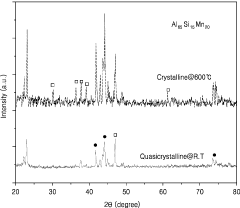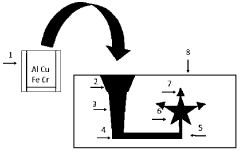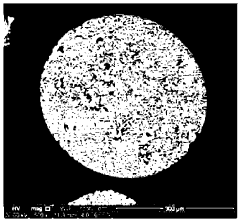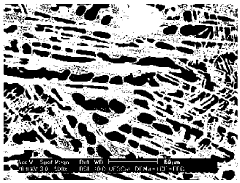Quasicrystal as a Conductor: Exploring Electrical Properties
Quasicrystal Conductivity Background and Objectives
Quasicrystals, discovered in 1982 by Dan Shechtman, represent a unique class of materials that challenge our traditional understanding of crystalline structures. These materials exhibit long-range order but lack periodicity, a characteristic that sets them apart from conventional crystals. The exploration of their electrical properties as conductors has become an increasingly important area of research in materials science and condensed matter physics.
The primary objective of this technical investigation is to comprehensively examine the electrical conductivity of quasicrystals, with a focus on their potential applications in various technological domains. This research aims to bridge the gap between theoretical understanding and practical implementation, potentially leading to innovative solutions in electronics, energy storage, and other fields where unique conductive properties are desirable.
Historically, the study of quasicrystals' electrical properties has evolved significantly since their initial discovery. Early research primarily focused on understanding the fundamental nature of these materials and their atomic arrangements. As our knowledge expanded, attention shifted towards exploring their physical properties, including electrical conductivity. This transition marked the beginning of a new era in quasicrystal research, with potential implications for both basic science and applied technology.
The current technological landscape presents both challenges and opportunities for quasicrystal conductivity research. With the increasing demand for novel materials in electronics and energy sectors, quasicrystals offer a promising avenue for innovation. Their unique structural properties suggest the possibility of unconventional electronic behaviors, which could lead to breakthroughs in areas such as thermoelectric materials, superconductors, or even quantum computing components.
As we delve into this investigation, it is crucial to consider the broader context of materials science and condensed matter physics. The study of quasicrystal conductivity intersects with various other fields, including solid-state physics, quantum mechanics, and materials engineering. This interdisciplinary nature necessitates a comprehensive approach, combining theoretical modeling, experimental techniques, and advanced characterization methods.
The technological goals of this research are multifaceted. Firstly, we aim to develop a deeper understanding of the mechanisms governing electrical conduction in quasicrystalline structures. This fundamental knowledge is essential for predicting and manipulating their electrical properties. Secondly, we seek to identify specific quasicrystalline compositions or structures that exhibit enhanced conductivity or other desirable electrical characteristics. Finally, we aspire to explore potential applications where the unique conductive properties of quasicrystals could offer significant advantages over conventional materials.
Market Potential for Quasicrystal Conductors
The market potential for quasicrystal conductors is rapidly expanding as researchers and industries recognize the unique electrical properties these materials possess. Quasicrystals, with their aperiodic yet ordered structure, offer a novel approach to electrical conduction that could revolutionize various sectors of the electronics industry.
One of the primary markets for quasicrystal conductors lies in the field of thermoelectric devices. The unusual electronic structure of quasicrystals results in low thermal conductivity coupled with relatively high electrical conductivity, making them ideal candidates for efficient thermoelectric materials. This property could lead to significant improvements in waste heat recovery systems, potentially tapping into a market valued in the billions of dollars across industries such as automotive, aerospace, and industrial manufacturing.
In the semiconductor industry, quasicrystal conductors show promise for developing new types of electronic components. Their unique band structure and electron transport properties could enable the creation of novel transistors and other devices with superior performance characteristics. This could open up new possibilities in high-speed computing and telecommunications, addressing the growing demand for faster and more energy-efficient electronic systems.
The renewable energy sector presents another significant market opportunity for quasicrystal conductors. Their potential application in solar cells and energy storage devices could enhance the efficiency of photovoltaic systems and improve the performance of batteries. As the global push for clean energy intensifies, the demand for advanced materials in this sector is expected to grow substantially.
Aerospace and defense industries are also showing interest in quasicrystal conductors due to their potential for creating lightweight, high-strength materials with unique electrical properties. These materials could find applications in advanced sensors, communication systems, and electronic warfare technologies, catering to a highly specialized and high-value market.
Moreover, the emerging field of quantum computing represents a long-term market opportunity for quasicrystal conductors. Their complex electronic structure could potentially be harnessed for quantum bit (qubit) implementations, contributing to the development of more stable and scalable quantum computing systems.
As research progresses and manufacturing techniques improve, the cost of producing quasicrystal conductors is expected to decrease, making them more competitive with traditional conducting materials. This cost reduction, coupled with their unique properties, could drive adoption across a wide range of industries, from consumer electronics to industrial automation.
Current State and Challenges in Quasicrystal Electrical Properties
The current state of research on the electrical properties of quasicrystals as conductors reveals a complex and intriguing landscape. Quasicrystals, discovered in 1982 by Dan Shechtman, possess a unique atomic structure that falls between crystalline and amorphous materials. This distinctive arrangement leads to unusual electrical behaviors that have puzzled scientists for decades.
Recent studies have shown that quasicrystals exhibit a wide range of electrical conductivity, from insulating to metallic, depending on their composition and structure. Some quasicrystals, particularly those containing aluminum and transition metals, display low electrical conductivity at room temperature, often orders of magnitude lower than their crystalline counterparts. This phenomenon is attributed to the presence of localized electronic states and the absence of periodic lattice structure.
One of the most significant challenges in understanding quasicrystal electrical properties is the lack of traditional band theory applicability. The absence of translational symmetry in quasicrystals renders conventional electronic structure calculations ineffective, necessitating the development of new theoretical frameworks. Researchers are currently exploring alternative approaches, such as tight-binding models and real-space methods, to better describe the electronic behavior of these materials.
Another major hurdle is the difficulty in synthesizing high-quality, large-scale quasicrystal samples. The complex stoichiometry and metastable nature of many quasicrystalline phases make it challenging to produce specimens suitable for detailed electrical characterization. This limitation has hindered progress in experimental studies and the potential application of quasicrystals in electronic devices.
The temperature dependence of electrical conductivity in quasicrystals presents yet another puzzle. Unlike typical metals, many quasicrystals exhibit increasing resistivity with decreasing temperature, a behavior reminiscent of semiconductors. This anomalous temperature dependence is not fully understood and is an active area of research, with implications for both fundamental physics and potential applications in thermoelectric devices.
Recent advancements in experimental techniques, such as scanning tunneling microscopy and angle-resolved photoemission spectroscopy, have provided new insights into the local electronic structure of quasicrystals. These methods have revealed the presence of pseudogaps near the Fermi level, which play a crucial role in determining the electrical properties of quasicrystals. However, connecting these microscopic observations to macroscopic electrical behavior remains a significant challenge.
The international scientific community is actively engaged in addressing these challenges, with research groups in Europe, Asia, and North America contributing to the field. Collaborative efforts are underway to develop standardized methods for quasicrystal synthesis and characterization, which will be crucial for advancing our understanding of their electrical properties and potential applications as conductors.
Existing Methods for Studying Quasicrystal Conductivity
01 Electrical conductivity of quasicrystals
Quasicrystals exhibit unique electrical properties due to their aperiodic structure. They often display low electrical conductivity compared to conventional crystalline materials, which can be attributed to their complex atomic arrangements. The electrical conductivity of quasicrystals can be influenced by factors such as composition, temperature, and structural defects.- Electrical conductivity of quasicrystals: Quasicrystals exhibit unique electrical properties due to their aperiodic structure. They often display low electrical conductivity compared to conventional crystalline materials, which can be attributed to their complex atomic arrangements. The conductivity of quasicrystals can be influenced by factors such as composition, temperature, and structural order.
- Thermoelectric properties of quasicrystals: Quasicrystals have shown promising thermoelectric properties, making them potential candidates for thermoelectric applications. Their unique structure contributes to low thermal conductivity while maintaining reasonable electrical conductivity, leading to improved thermoelectric efficiency. Research focuses on optimizing composition and processing to enhance these properties.
- Electronic structure and band gap in quasicrystals: The electronic structure of quasicrystals is complex due to their aperiodic nature. They often exhibit a pseudogap near the Fermi level, which affects their electrical properties. Studies have focused on understanding the relationship between the quasicrystalline structure and the resulting electronic band structure, including the presence of localized states and their impact on conductivity.
- Surface electrical properties of quasicrystals: The surface electrical properties of quasicrystals can differ significantly from their bulk properties. Research has explored the unique surface states and their impact on electrical conductivity, as well as potential applications in surface coatings and thin films. Surface modification techniques have been developed to tailor the electrical properties for specific applications.
- Doping and alloying effects on electrical properties: Doping and alloying have been investigated as methods to modify the electrical properties of quasicrystals. By introducing specific elements or creating quasicrystalline alloys, researchers aim to enhance conductivity or tailor other electrical characteristics. These approaches offer potential for developing quasicrystalline materials with improved or specialized electrical properties for various applications.
02 Thermoelectric properties of quasicrystals
Quasicrystals have shown promising thermoelectric properties, making them potential candidates for thermoelectric applications. Their unique structure allows for high electrical resistivity combined with low thermal conductivity, which is beneficial for thermoelectric efficiency. Research has focused on optimizing the composition and processing of quasicrystalline materials to enhance their thermoelectric performance.Expand Specific Solutions03 Electronic structure and band gap in quasicrystals
The electronic structure of quasicrystals is complex due to their aperiodic nature. They often exhibit a pseudogap near the Fermi level, which affects their electrical properties. Studies have investigated the band structure and density of states in various quasicrystalline systems to better understand their electronic behavior and potential applications in electronic devices.Expand Specific Solutions04 Surface electrical properties of quasicrystals
The surface electrical properties of quasicrystals can differ significantly from their bulk properties. Research has focused on understanding surface conductivity, work function, and electron emission characteristics of quasicrystalline surfaces. These properties are relevant for potential applications in coatings, sensors, and electronic devices.Expand Specific Solutions05 Doping and modification of quasicrystals for electrical applications
Efforts have been made to modify the electrical properties of quasicrystals through doping or compositional adjustments. This approach aims to tailor the electrical characteristics for specific applications, such as improving conductivity or enhancing thermoelectric performance. Research has explored various dopants and processing techniques to achieve desired electrical properties in quasicrystalline materials.Expand Specific Solutions
Key Players in Quasicrystal Electrical Research
The exploration of electrical properties in quasicrystals as conductors is an emerging field in materials science, currently in its early developmental stage. The market size for this technology is relatively small but growing, driven by potential applications in electronics and energy sectors. The technology's maturity is still low, with ongoing research to fully understand and exploit quasicrystals' unique properties. Companies like Corning, Inc., Samsung Electronics Co., Ltd., and TDK Corp. are investing in research and development, while academic institutions such as Nanjing University and Boston University are contributing to fundamental knowledge. As the technology progresses, we can expect increased interest from both established electronics manufacturers and innovative startups, potentially leading to novel applications in conductivity and energy efficiency.
Semiconductor Energy Laboratory Co., Ltd.
Fujitsu Ltd.
Breakthrough Discoveries in Quasicrystal Electrical Properties
- A polyhedral quasicrystalline material with long-range translational order and rotational symmetry is used in the phase change layer, enabling phase transitions between quasi-crystalline and crystalline states with minimal energy change, allowing for fast phase transitions.
- A method for manufacturing aluminum matrix composites using the Al-Cu-Fe-Cr system, allowing for the formation of a stable decagonal quasicrystalline phase through conventional metallurgical processes, including alloy melting, solidification, and optional heat treatment, without the need for high cooling rates or mechanical mixing.
Materials Science Implications of Quasicrystal Conductivity
The discovery of quasicrystals has opened up new avenues for materials science research, particularly in the realm of electrical conductivity. Quasicrystals, with their unique aperiodic structures, exhibit electrical properties that challenge conventional understanding of conductors and insulators. This has significant implications for materials science and potential applications in various fields.
One of the most intriguing aspects of quasicrystal conductivity is its temperature dependence. Unlike typical metallic conductors, quasicrystals often display increased resistivity at lower temperatures. This behavior, known as inverse Matthiessen's rule, suggests that the electronic transport mechanisms in quasicrystals differ fundamentally from those in periodic crystals. Understanding these mechanisms could lead to the development of novel materials with tailored electrical properties.
The study of quasicrystal conductivity has also revealed the importance of structural order in determining electrical properties. While perfect quasicrystals tend to be poor conductors, introducing controlled disorder can enhance their conductivity. This finding challenges the traditional notion that structural perfection is always desirable for optimal electrical performance. It opens up possibilities for designing materials with specific conductivity profiles by manipulating their degree of quasiperiodicity.
Furthermore, the anisotropic nature of quasicrystal conductivity presents opportunities for directional control of electrical properties. Some quasicrystals exhibit significantly different conductivities along different crystallographic directions. This anisotropy could be exploited in the development of direction-sensitive electronic components or in the creation of materials with programmable conductivity patterns.
The study of quasicrystal conductivity has also led to advancements in our understanding of electron localization and transport in complex structures. The presence of phason modes, unique to quasicrystals, introduces additional complexity to electron scattering processes. This has prompted the development of new theoretical models to describe electronic behavior in aperiodic systems, potentially applicable to a wider range of disordered materials.
In terms of practical applications, the unique conductivity properties of quasicrystals have sparked interest in their use as thermoelectric materials. Their low thermal conductivity coupled with tunable electrical conductivity makes them promising candidates for efficient thermoelectric devices. This could have far-reaching implications for energy harvesting and thermal management technologies.
Potential Applications of Quasicrystal Conductors
The potential applications of quasicrystal conductors are diverse and promising, spanning various industries and technological domains. One of the most significant areas of interest is in the field of electronics, where quasicrystals' unique electrical properties could revolutionize the design and performance of electronic components.
In the semiconductor industry, quasicrystal conductors may offer novel solutions for creating more efficient and compact integrated circuits. Their distinctive electronic structure could potentially lead to the development of faster and more energy-efficient microprocessors, enhancing the overall performance of computing devices.
The automotive sector presents another exciting avenue for quasicrystal conductor applications. These materials could be utilized in the development of advanced sensors and control systems, improving the efficiency and safety of electric and autonomous vehicles. Additionally, their unique properties may contribute to the creation of more durable and lightweight electrical components for automotive applications.
In the realm of energy technology, quasicrystal conductors show promise for enhancing the efficiency of solar cells and other renewable energy systems. Their unusual electronic properties could potentially lead to the development of more effective photovoltaic materials, thereby increasing the overall efficiency of solar energy conversion.
The aerospace industry stands to benefit from the application of quasicrystal conductors in the development of lightweight, high-performance materials for aircraft and spacecraft. These materials could contribute to the creation of more efficient electrical systems and sensors, crucial for advancing space exploration and satellite technology.
In the field of telecommunications, quasicrystal conductors may play a role in the development of next-generation antennas and signal processing devices. Their unique electronic properties could potentially lead to improvements in signal transmission and reception, enhancing the performance of wireless communication systems.
The medical industry also presents opportunities for quasicrystal conductor applications, particularly in the development of advanced diagnostic and imaging equipment. These materials could contribute to the creation of more sensitive and accurate medical sensors, improving the detection and treatment of various health conditions.
As research in this field progresses, it is likely that new and unexpected applications for quasicrystal conductors will emerge, potentially revolutionizing various aspects of technology and industry. The continued exploration of these materials' electrical properties holds great promise for driving innovation across multiple sectors.
